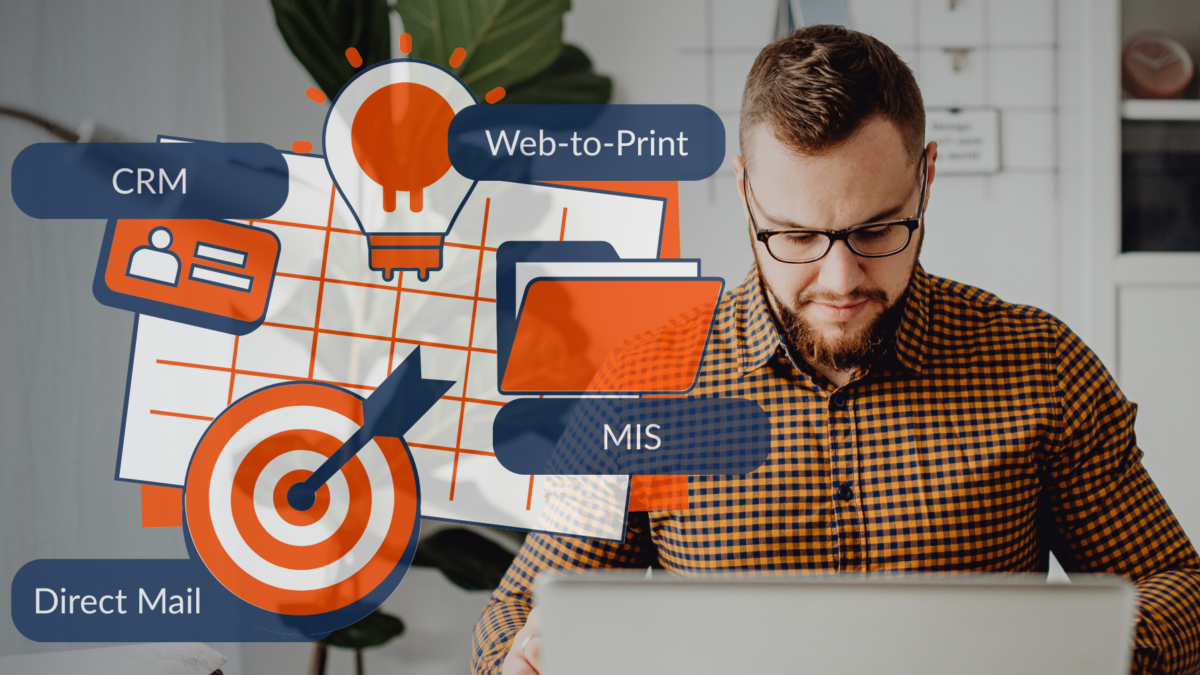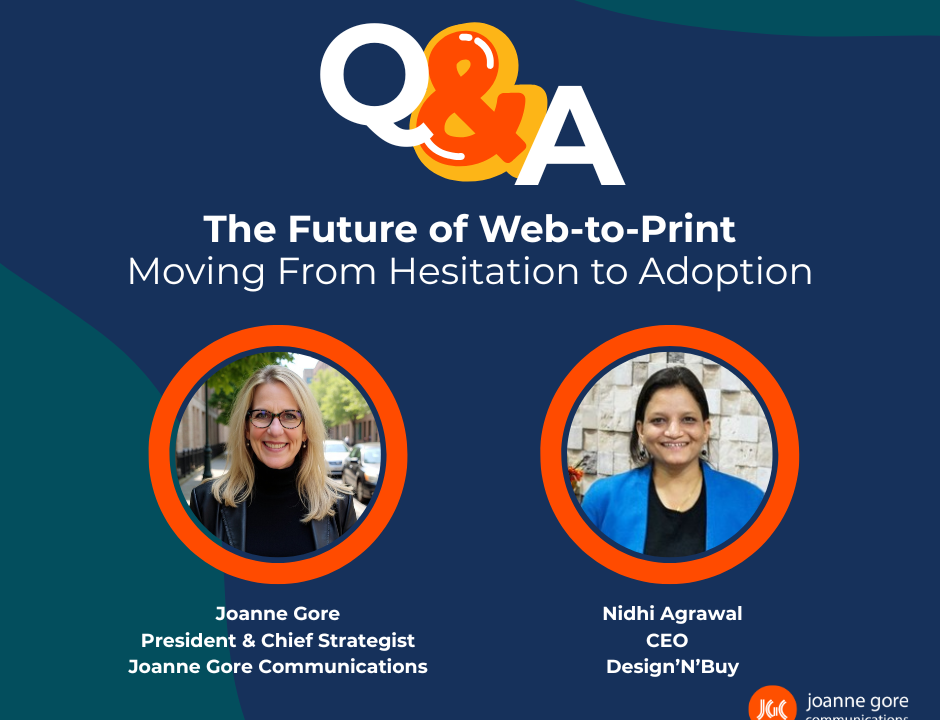The Tech-Driven Print Business: What PSPs Need to Know Now, Next, and Later
Print providers today face a landscape shaped by two converging forces: the rapid evolution of print-enabling technologies, and the ever-expanding marketing technology (MarTech) stack that surrounds them. Whether you’re a commercial, trade, packaging, or wide-format printer, your buyers expect more – more touchpoints, more flexibility, more speed, and more value. Staying competitive means staying ahead of technology trends, not just in the pressroom but also in the boardroom and online.
This article explores how 10 key technologies have transformed the print industry – and how the right MarTech stack can help PSPs drive growth, efficiency, and revenue.
10 Technologies Reshaping Print
The print industry continues its rapid transformation, with Smithers forecasting the global digital print market to grow from approximately $167.5 billion in 2025 to $251.1 billion by 2035, while digital printing alone is expected to reach $225 billion by 2029 at a 5.3 percent CAGR (source). These figures highlight how technologies once seen as optional – like AI, AR, RFID, and eco materials – are now essential tools for PSPs aiming to boost efficiency, personalization, sustainability, and profitability.
The following 10 innovations reflect the new blueprint for success in print.
- Digital Printing Presses
Modern digital presses offer high-speed, high-quality output across a wide range of substrates. Short-run and on-demand printing is now routine, with advances in inkjet and toner delivering sharper colour, faster turnaround, and expanded market access – particularly in packaging and personalized print. - Artificial Intelligence (AI)
AI is more than a buzzword – it’s a core operational tool. PSPs use AI to streamline file prep, optimize layouts, reduce waste, and deliver hyper-personalized campaigns. Infigo notes AI can process 10,000 files in just minutes – work that would take a human weeks. - Augmented Reality (AR) and Interactive Print
AR bridges physical and digital touchpoints. From packaging to direct mail, interactive print lets brands tell stories, guide actions, and boost conversions. When Lionsgate added QR codes to its campaigns, they saw more than 12,000 engagements in 65 cities. - 3D Printing
3D printing continues to move from novelty to necessity. PSPs now use 3D print for everything from prototypes to spare parts. It’s especially valuable in remote locations where press downtime needs to be resolved fast. - Sustainable Materials
Sustainability remains top of mind. Printers are reducing their footprint by embracing recyclable substrates, de-inking solutions, and energy-efficient equipment. Xeikon’s eco-toner, made with 60% recyclable materials, has cut the carbon footprint of some print jobs by over 10%. - Cloud Computing
Cloud-based systems have changed how teams collaborate. From remote file sharing to online proofing and job tracking, the cloud delivers flexibility, speed, and secure access to workflows, regardless of location. - Big Data and Analytics
Data is the new differentiator. Advanced analytics help PSPs understand customer behaviour, forecast trends, and optimize campaigns. Real-time insights support smarter pricing, scheduling, and resource allocation. - Web-to-Print/Web-to-Pack
W2P technology now mirrors the consumer experience of platforms like Amazon. Today’s tools support custom design, real-time proofing, payment integration, and job tracking – giving clients control and printers efficiency. According to Shopify’s Oberlo, by 2029 the number of online shoppers in the U.S. is projected to reach 333.5 million. - RFID and Smart Packaging
RFID is gaining ground as brands seek greater traceability and interactivity. From anti-counterfeit measures to intelligent inventory management, smart packaging creates new touchpoints while increasing transparency and trust. - Workflow Automation
Automation is transforming prepress, press, and post-press workflows. Integrated software solutions connect estimating, scheduling, printing, and finishing to reduce errors, speed up jobs, and increase margins.
The Role of MarTech in the Print Industry
While these technologies transform operations, MarTech enables PSPs to amplify their own marketing – attracting, converting, and retaining customers more effectively. MarTech (short for marketing technology) refers to the software and platforms that help manage campaigns, analyze performance, and improve communication. Your MarTech Stack is the combination of tools you use to do it all – from CRM to email to analytics.
There are more than 14,000 MarTech solutions in 2025, up from 10,000 just two years ago – a 40% surge reflecting the accelerating demand for data-driven, omnichannel customer engagement. Industry leaders like HubSpot, Salesforce, Adobe, Oracle, and Mailchimp continue to dominate core categories like CRM, marketing automation, and customer experience. At the same time, up-and-comers such as Brevo (formerly Sendinblue), ActiveCampaign, Zoho, and Klaviyo are gaining traction with more accessible, modular platforms designed for small to mid-sized businesses. Choosing the right mix starts with understanding how each technology maps to your specific goals, resources, and growth trajectory – ensuring your MarTech stack supports not just where you are now, but where you want to go.
The most successful companies plan ahead, test new tools, and optimize based on results. They are diligent at:
- Keeping the CRM database clean and up to date
- Ensuring the W2P store is SEO-optimized and user-friendly
- Measuring results from campaigns – and adjusting as needed
- Prioritizing tech investments that improve client experience and internal efficiency
No two stacks are the same, but most include some variation of:
- Google Analytics – Understand website traffic and visitor behaviour
- CMS (like WordPress) – Manage and publish web content
- CRM – Track contacts, leads, and customer journeys
- MAP (Marketing Automation Platform) – Nurture leads, send campaigns, and trigger actions
Use free trials, lean into your network, and assess tools not just by what they do – but by what they help you achieve.
Key Drivers Behind MarTech Adoption:
- The Cloud makes it easier to manage and integrate tools from anywhere.
- Short Attention Spans demand more engaging, personalized, multichannel content.
- Data helps identify who is ready to buy – and how to reach them quickly.
Print-Specific MarTech Platforms Worth Watching
While mainstream MarTech platforms serve broad business needs, several print industry-specific platforms stand out for their ability to integrate storefronts, workflows, pricing, and communications tailored to PSPs, in-plants, and packaging firms.
🖥️ Web-to-Print / Online Storefronts
- Infigo – Highly customizable with MIS and CRM integrations.
- OnPrintShop – B2B portals, artwork automation, job management.
- CloudLab (printQ/packQ) – 3D visualization and complex packaging configurators.
- Propago – Asset management meets procurement and fulfillment.
📦 MIS / Print Business Management with CRM/Marketing Capabilities
- PrintIQ – Cloud-based estimating, inventory, and workflow platform.
- PressWise – MIS with integrated CRM and shipping.
- Tharstern – Estimating, scheduling, and CRM for hybrid print environments.
- Avanti Slingshot (by ePS) – Post-Ricoh acquisition, now part of the Print ePS portfolio, Slingshot continues to support commercial printers with robust CRM, job ticketing, and MarTech integrations.
- DocketManager – A full MIS suite with built-in CRM, email marketing templates, and web-to-print storefronts. It sits at the intersection of business management and light marketing automation, making it ideal for small to mid-sized PSPs who want an all-in-one solution.
✉️ Direct Mail Automation / Optichannel Marketing
- Postalytics – Direct mail automation with CRM and campaign tracking.
- Lob – API-based, personalized print mailing at scale.
- MindFire – Print-centric multichannel campaign orchestration.
📊 Business Intelligence and Strategic Enablement
- EFI MarketDirect – Supports print + digital campaign management.
- XMPie (by Xerox) – For personalized, data-driven multichannel communications.
- Planned Profit – Focused on real-time profit modeling, pricing intelligence, and sales strategy alignment. While not a traditional MarCom tool, it plays a crucial role in helping PSPs define profitable market segments, support pricing strategies, and ensure alignment between sales and marketing decisions.
7 Questions to Ask Before You Invest
MarTech is exploding – and so is the complexity. The current Martech landscape now includes a staggering 15,384 solutions, up 9 percent from 14,106 in 2024 (source). With tools multiplying every year, decision fatigue is real – but so is opportunity. Asking the right questions about goals, budget, scalability, and ROI is the only reliable way to build a stack that drives measurable results. Below are seven essential questions to guide every tech investment – from selection to evaluation.
- What short-term goals will this technology help us achieve?
- Is our current system working, or is it holding us back?
- What is our budget for implementation and ongoing use?
- What kind of ROI can we expect?
- Who will use and manage the software?
- Will this tool grow with us?
- How will we measure success?
By combining production technologies with the right marketing stack, you can position your business to do more with less – faster, smarter, and with greater impact.
Turning Tech Investment Into Real-World Results
Building the right MarTech stack is only part of the equation. To fully realize its potential, your messaging must be just as strategic as your technology. After all it’s clarity, consistency, and customer connection that wins. That’s where a Messaging Playbook comes in. It aligns your team around a shared language to define who you help, how you help, and why it matters.
Download the case study to see how Sun Print Solutions used a Messaging Playbook to unify their voice and drive measurable ROI: The ROI of a Messaging Playbook – featuring Sun Print Solutions




